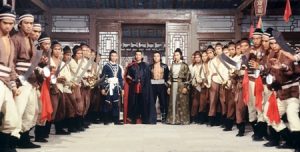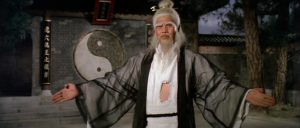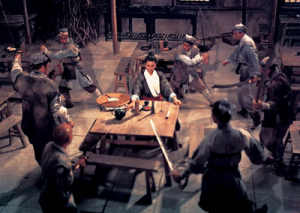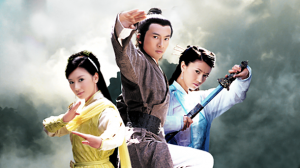Art of Wuxia Design Guidelines, Part 4 Mysticism
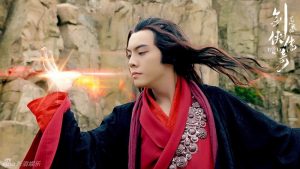
Before beginning work on Art of Wuxia I developed a list of things that I wanted out of the game. Before every writing session and play test session, I take that list out and read it. My rule is that the list must absolutely be followed to keep the design of the game focused on its most important parts. The next few articles will cover this list and explain why I feel each of these guidelines was important for Art of Wuxia.
Wuxia is a broad genre category. There are many sub genres, some that don’t have any magic at all and others where nearly everyone has mystical powers such as magic or chi. Art of Wuxia has magic in it at about the same level as BareBones Fantasy (typical fantasy RPG fare) but there are notes in the GM section showing how to add more fantasy and magic or remove it entirely. We want to give you the tools you need to play the type of wuxia you want to play which means providing lots of options.
Design Guideline: Magic should integrate. BareBones Fantasy already has an excellent magic system. For Art of Wuxia, some spells were dropped and others added and a few altered to fit the genre. Genre examples are given wherever possible so players and GMs have ideas to work with. Alchemical items are right in the Equipment lists to purchase and the rules on spell acquisition altered so that finding old magic tombs becomes very desirable thus promoting exploration into dangerous old trap filled tombs of ancient evil sorcerers.

Two new skills are added to Art of Wuxia that specifically address wuxia mysticsm, the Diviner and the Mystic. A diviner can see the future and it has been a real hit with play testers. The mystic is like a detective for the occult, sensing aura’s, evil and even areas of chi. These skills add a lot to the flavor of Art of Wuxia. They can also be dropped if you are looking for less magic in your game.
Design Guideline: Chi should be baked into the system. Chi is absolutely an essential element of wuxia stories. Chi act a bit like hero points in other games but are designed to enforce the tropes of the genre. Most everything chi is shown to be able to do in wuxia stories is possible in Art of Wuxia. Chi can be used to heal someone, expel a poison, add extra effort to actions, leap over walls and more. Sworn brothers/sisters can even share their Chi pool. I’ll talk more about that another time.
Design Guideline: Lightness skills should enable huge leaps and running or skipping across water. Wuxia wouldn’t be wuxia without highflying action. And highflying action in wuxia comes from lightness skills. In Art of Wuxia lightness is a chi ability granted early on by internal kung fu styles and later on in external kung fu styles. Players love the tactical options it provides and GMs are encouraged to make their battle encounters three dimensional. Bad guys should be knocked off balconies and there should be sword fights on rooftops or atop torii gates.
Design Guideline: There should be demons & spirits. Ghost stories and plots around evil spirits or sorcerers summoning demons show up in many wuxia tales. Most creatures encountered in Art of Wuxia are either normal animals or some sort of spirit. Some spirits can take human form. Truly evil spirits become demons and are consumed by their hungers. The creatures and sample setting provide many adventure hooks for integrating them in play.
THE META GUIDELINES

These last two guidelines don’t really fit in any category but they have shaped every aspect of Art of Wuxia.
Design Guideline: If it isn’t fun, get rid of it. This guideline is really the ultimate arbiter of what goes in the game and what stays. This has been the most important guideline of them all. Art of Wuxia is about wuxia and that means great action and drama. If these things aren’t fun, there isn’t any point to playing. I have no qualms about throwing out pages of hard work if it doesn’t contribute to fun at the table. If it is part of the other guidelines, of course we try to make it work but ultimately no one wants to play a game that isn’t fun. And if something isn’t fun, it is dropped.
Now is this subjective! Absolutely. No group of people can agree about whether everything is fun. There will be differences. But still…if you like the tropes of wuxia, and your game supports the wuxia style with ease and gets out of the way and your players are smiling and really getting into their characters I think you have found your fun.
Design Guideline: Unofficial Litmus When watching wuxia movies or tv shows or reading wuxia books I constantly ask myself, “can Art of Wuxia do that?” Actually, now my play test group players are doing that. They see things in movies and then try to pull them off in the game. It is working very well. That feeds back to the fun guideline.
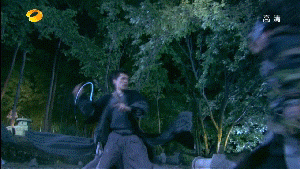
I’m not promising that Art of Wuxia will be the ultimate wuxia RPG for everyone. I can confidently say it is my favorite RPG and I think it is measuring up nicely. I can’t wait till it leaves its kung fu school and makes its way out into the world and into your hands. I cannot wait to see what it becomes as others take it in new directions.


